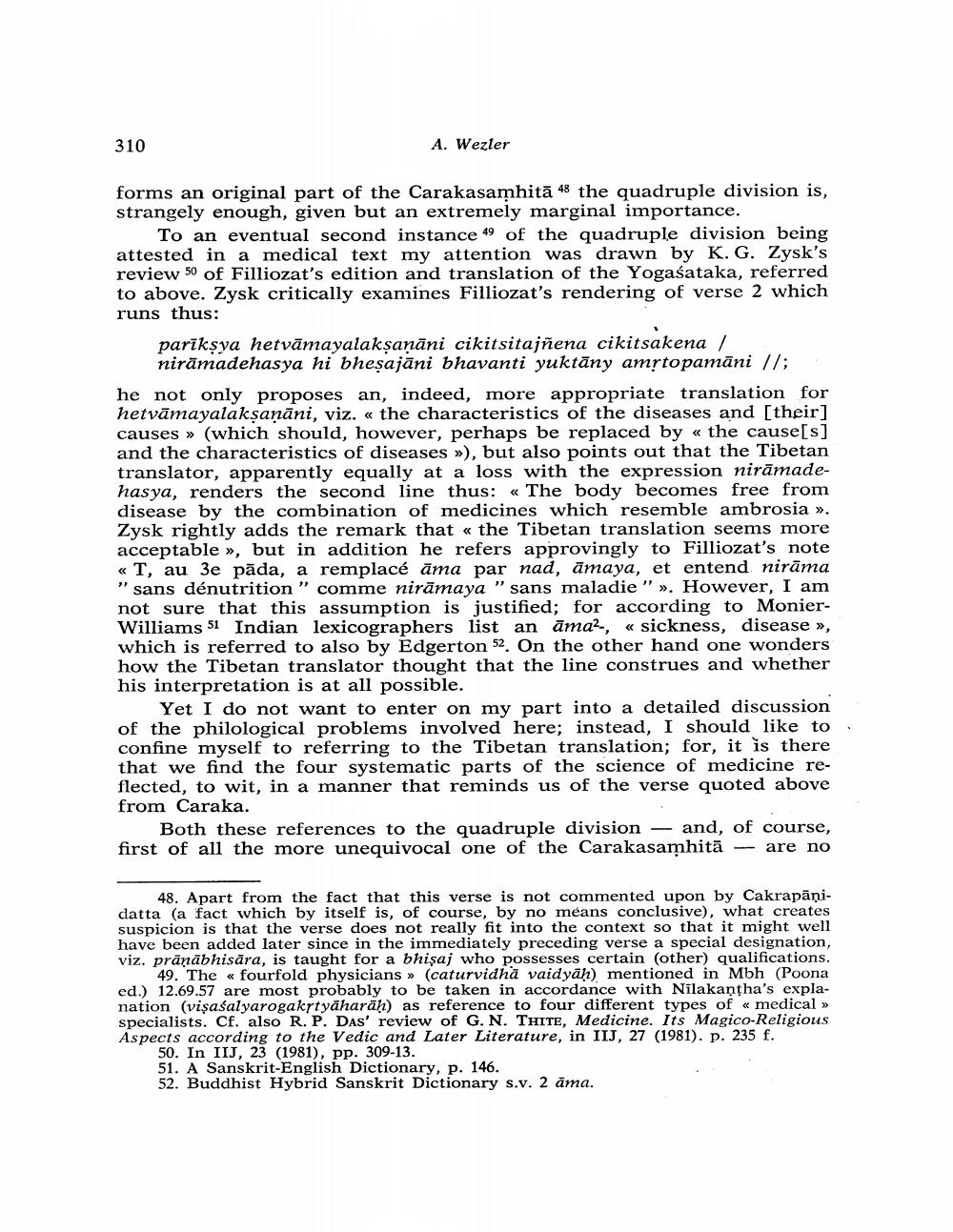________________
310
A. Wezler
forms an original part of the Carakasamhitā 48 the quadruple division is, strangely enough, given but an extremely marginal importance.
To an eventual second instance 49 of the quadruple division being attested in a medical text my attention was drawn by K. G. Zysk's review 50 of Filliozat's edition and translation of the Yogaśataka, referred to above. Zysk critically examines Filliozat's rendering of verse 2 which runs thus:
parīksya hetvāmayalaksanāni cikitsitajñena cikitsakena /
nirāmadehasya hi bheşajāni bhavanti yuktāny amstopamāni //; he not only proposes an, indeed, more appropriate translation for hetvāmayalaksaņāni, viz. «the characteristics of the diseases and [their] causes » (which should, however, perhaps be replaced by the cause[s] and the characteristics of diseases »), but also points out that the Tibetan translator, apparently equally at a loss with the expression nirāmadehasya, renders the second line thus: «The body becomes free from disease by the combination of medicines which resemble ambrosia ». Zysk rightly adds the remark that « the Tibetan translation seems more acceptable », but in addition he refers approvingly to Filliozat's note « T, au 3e pada, a remplacé āma par nad, āmaya, et entend nirāma "sans dénutrition " comme nirāmaya " sans maladie" ». However, I am not sure that this assumption is justified; for according to MonierWilliams 51 Indian lexicographers list an āma,« sickness, disease », which is referred to also by Edgerton 52. On the other hand one wonders how the Tibetan translator thought that the line construes and whether his interpretation is at all possible.
Yet I do not want to enter on my part into a detailed discussion of the philological problems involved here; instead, I should like to confine myself to referring to the Tibetan translation; for, it is there that we find the four systematic parts of the science of medicine reflected, to wit, in a manner that reminds us of the verse quoted above from Caraka.
Both these references to the quadruple division — and, of course, first of all the more unequivocal one of the Carakasamhitā — are no
48. Apart from the fact that this verse is not commented upon by Cakrapāņidatta (a fact which by itself is, of course, by no means conclusive), what creates suspicion is that the verse does not really fit into the context so that it might well have been added later since in the immediately preceding verse a special designation, viz. prānābhisära, is taught for a bhișaj who possesses certain (other) qualifications.
49. The « fourfold physicians » (caturvidha vaidyāḥ) mentioned in Mbh (Poona ed.) 12.69.57 are most probably to be taken in accordance with Nilakantha's explanation (vişaśalyarogakrtyäharā) as reference to four different types of medical >> specialists. Cf. also R. P. Das' review of G. N. THITE, Medicine. Its Magico-Religious Aspects according to the Vedic and Later Literature, in IIJ, 27 (1981). p. 235 f.
50. In IIJ, 23 (1981), pp. 309-13. 51. A Sanskrit-English Dictionary, p. 146. 52. Buddhist Hybrid Sanskrit Dictionary s.v. 2 āma.




